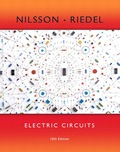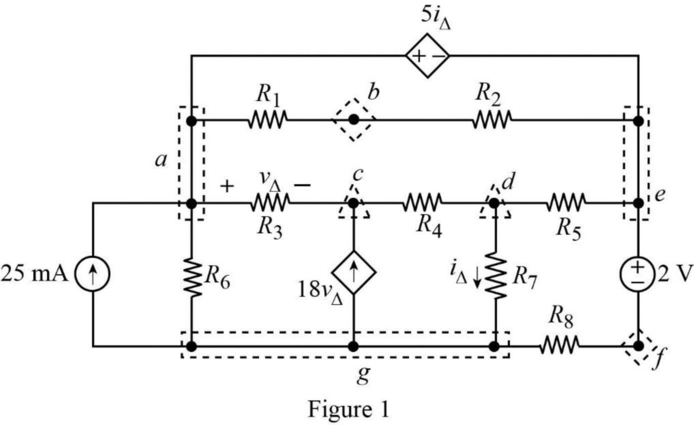
Concept explainers
(a)
Calculate the number of branches in the circuit.
(a)
Answer to Problem 1P
The number of branches in the circuit is 12 branches.
Explanation of Solution
Given data:
Refer to Figure P4.1 in the textbook.
The given circuit is modified as shown in Figure 1.

A branch is defined as a single electrical device or elements.
In Figure 1, there are 12 branches in the circuit. They are,
That is, 2 branch with a dependent source, 2 branches with independent sources, and 8 branches with resistors.
Conclusion:
Thus, the number of branches in the circuit is 12 branches.
(b)
Find the number of branches where the current is unknown.
(b)
Answer to Problem 1P
The number of branches in which the current unknown is 11 branches.
Explanation of Solution
Given data:
Refer to Figure 1 in Part (a).
In Figure 1, the only one known current in the circuit which is the
Conclusion:
Thus, the number of branches in which the current unknown is 11 branches.
(c)
Find the number of essential branches in the circuit.
(c)
Answer to Problem 1P
The number of essential branches in the circuit is 10 essential branches.
Explanation of Solution
Given data:
Refer to Figure 1 in Part (a).
Essential branch: It is defined as a path that attaches essential nodes without passing through an essential node.
The essential branches in the circuit are,
In the circuit,
Therefore, the circuit has 10 essential branches.
Conclusion:
Thus, the number of essential branches in the circuit is 10 essential branches.
(d)
Find the number of essential branches where the current is unknown in the circuit.
(d)
Answer to Problem 1P
The number of essential branches where the current unknown is 9 essential branches.
Explanation of Solution
Given data:
Refer to Figure 1 in Part (a).
Refer to Part (c), the circuit has 10 essential branches.
In Figure 1, the current is known only in the essential branch that containing the
Therefore, in 9 essential branches the current is unknown.
Conclusion:
Thus, the number of essential branches where the current unknown is 9 essential branches.
(e)
Find the number of nodes in the circuit.
(e)
Answer to Problem 1P
The number of nodes in the circuit is 7 nodes.
Explanation of Solution
Given data:
Refer to Figure 1 in Part (a).
Node: It is defined as a connection point between two or more branches.
In Figure 1, the nodes present in the circuit are,
Conclusion:
Thus, the number of nodes in the circuit is 7 nodes.
(f)
Find the number of essential nodes in the circuit.
(f)
Answer to Problem 1P
The number of essential nodes in the circuit is 5 essential nodes.
Explanation of Solution
Given data:
Refer to Figure 1 in Part (a).
Essential node: It is a node that joins three or more electrical element or devices
In Figure 1, the essential nodes present in the circuit are
Conclusion:
Thus, the number of essential nodes present in the circuit is 5 essential nodes.
(g)
Find the number of meshes present in the circuit.
(g)
Answer to Problem 1P
The number of meshes present in the circuit is 6 meshes.
Explanation of Solution
Given data:
Refer to Figure 1 in Part (a).
Mesh: It is defined as a closed loop path that has no any other smaller loops present inside.
In Figure 1, the closed loops present in the circuit are
Conclusion:
Thus, the number of meshes present in the circuit is 6 meshes.
Want to see more full solutions like this?
Chapter 4 Solutions
EBK ELECTRIC CIRCUITS
Additional Engineering Textbook Solutions
Starting Out with C++ from Control Structures to Objects (9th Edition)
Starting Out with Python (4th Edition)
Starting Out with Java: From Control Structures through Objects (7th Edition) (What's New in Computer Science)
Starting Out With Visual Basic (8th Edition)
Web Development and Design Foundations with HTML5 (8th Edition)
INTERNATIONAL EDITION---Engineering Mechanics: Statics, 14th edition (SI unit)
- HW3: A 9.375-GHz uniform plane wave is propagating in polyethylene (&-2.26). If the amplitude of the electric field intensity is 500 V/m and the material is assumed to be lossless, find: (a) the phase constant; (b) thearrow_forwardHW1: The location of the sliding bar in Figure below is given by x = 5t + 2t³, and the separation of the two rails is 20 cm. Let B = 0.8x2a, T. Find the voltmeter reading at (a) t = 0.4 s; (b) x = 0.6 m.arrow_forwardFor the circuit shown in Fig. 2.18, he =1.1 K2, hfe =50. Find Avf, Rif and Rof. { Ans: -3.2; 1935; X2807. Ans:-3-2;193;728. Vcc Rs=10kQ RF = 40kQ Re=4KQ -ov Vsarrow_forward
- For the system shown in figure below, the per unit values of different quantities are E-1.2, V 1, X X2-0.4. Xa-0.2 Determine whether the system is stable for a sustained fault. The fault is cleared at 8-60°. Is the system stable? If so find the maximum rotor swing. Find the critical clearing angle. E25 G X'd 08 CB X2 F CB V28 Infinite busarrow_forward17 For the circuit shown in Fig. 2.20, the transistors are identical and have the following parameters: hfe = 50, hie 1.1K, hre = 0, and hoe = 0. Calculate Auf, Rif and Rof. 25 V {Ans #45.4; 112 KM; 129 150k 47k www www +11 www 10k 6 4.7k 50μF Rif R₂1000 w 4.7k 47k Vo Q2 33k 4.7k ww 50µF 5μF 4.7k 1 R₁ Rofarrow_forwardFor the circuit shown in Fig. 2.18, he =1.1 K2, hfe =50. Find Avf, Rif and Rof. { Ans: -3.2; 1935; X2807. Ans:-3-2;193;728. Vcc Rs=10kQ RF = 40kQ Re=4KQ -ov Vs Fig. 2.18 Circuit for Q5.arrow_forward
- The circuit of Fig. 2.16 is to have Af=-1mA/V, D=1+ BA = 50, a voltage gain of -4, Rs =1KQ, and hfe = 150. Find RL, Re, Rif and Rof.. Vcc www RL OV Ans: 4 kor; 98053150 KS;∞. { An Re Fig. 2.16 Circuit for Q3.arrow_forwardDuring the lab you will design and measure a differential amplifier, made with an opamp. inside generator R5 ww 500 V1 0.1Vpk 1kHz 0° R6 w 50Ω R1 ww 10ΚΩ VCC C1 balanced wire R3 w 15.0V signal+ 100nF U1A TL082CP ground 2 signal- R4 w C2 Question5: Calculate R3 and R4 for a 20dB. 100nF VEE -15.0V R2 ww 10ΚΩarrow_forwardnot use ai pleasearrow_forward
- 3. Consider the system described by the transfer function Gp(s) polynomial controller to satisfy the below specifications: 1) The settling time is t = 1 second, 2) 0.1% peak overshoot, 3) and zero steady-state error for a ramp input. The sampling period is T = 0.01 second. 1 = Design a discrete-time s(s+5)*arrow_forwardProblem 2 Does there exist a value a that makes the two systems S₁ and S₂ equal? If so, what is this value ? If not, explain why. S₁ x[n] x[n] D D -2 → host 回洄 S with h[m] " 999. усиз -1012345 harrow_forwardplease not use any aiarrow_forward
 Introductory Circuit Analysis (13th Edition)Electrical EngineeringISBN:9780133923605Author:Robert L. BoylestadPublisher:PEARSON
Introductory Circuit Analysis (13th Edition)Electrical EngineeringISBN:9780133923605Author:Robert L. BoylestadPublisher:PEARSON Delmar's Standard Textbook Of ElectricityElectrical EngineeringISBN:9781337900348Author:Stephen L. HermanPublisher:Cengage Learning
Delmar's Standard Textbook Of ElectricityElectrical EngineeringISBN:9781337900348Author:Stephen L. HermanPublisher:Cengage Learning Programmable Logic ControllersElectrical EngineeringISBN:9780073373843Author:Frank D. PetruzellaPublisher:McGraw-Hill Education
Programmable Logic ControllersElectrical EngineeringISBN:9780073373843Author:Frank D. PetruzellaPublisher:McGraw-Hill Education Fundamentals of Electric CircuitsElectrical EngineeringISBN:9780078028229Author:Charles K Alexander, Matthew SadikuPublisher:McGraw-Hill Education
Fundamentals of Electric CircuitsElectrical EngineeringISBN:9780078028229Author:Charles K Alexander, Matthew SadikuPublisher:McGraw-Hill Education Electric Circuits. (11th Edition)Electrical EngineeringISBN:9780134746968Author:James W. Nilsson, Susan RiedelPublisher:PEARSON
Electric Circuits. (11th Edition)Electrical EngineeringISBN:9780134746968Author:James W. Nilsson, Susan RiedelPublisher:PEARSON Engineering ElectromagneticsElectrical EngineeringISBN:9780078028151Author:Hayt, William H. (william Hart), Jr, BUCK, John A.Publisher:Mcgraw-hill Education,
Engineering ElectromagneticsElectrical EngineeringISBN:9780078028151Author:Hayt, William H. (william Hart), Jr, BUCK, John A.Publisher:Mcgraw-hill Education,





